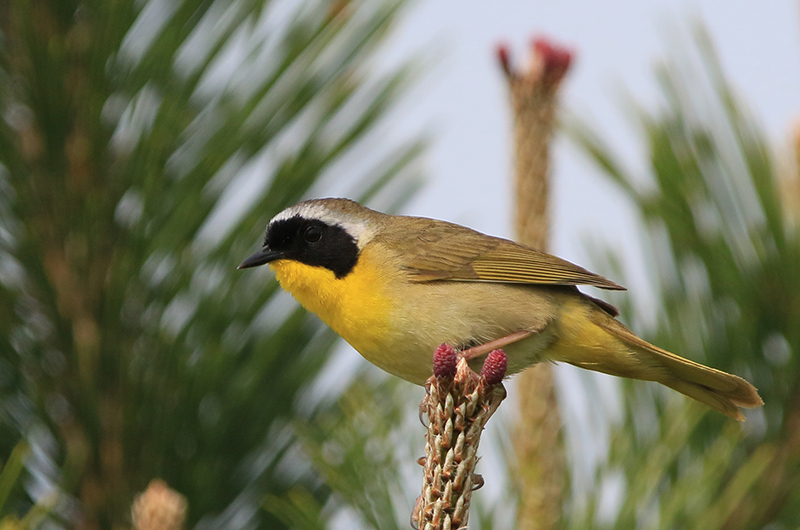Most bird feeders have been taken down to maintain social distancing between birds because a disease of unknown cause has killed birds in the mid-Atlantic states this year. It is thought to be related to the outbreak of cicadas, but the cause and transmission of the disease is not known.
But we have learned the hard way that disease spreads with close contact, true for birds as well as people. The Cornell Laboratory of Ornithology reports that most states have now lifted their do-not-feed-the-birds recommendations, so MassAudubon says that it is safe to start feeding birds again.
On the shorebird front, there are a number of less-than-common species flying around. Red knots have finally showed up. Max Chalfin-Jacobs saw one adult at Wasque on August 24 and three at Norton Point the next day. At Norton Point, Shea Fee saw one on August 25 and two were seen by both David Padulo and Allan Keith on August 29. The latter observer also found an adult from the prairie (western) race of short-billed dowitchers.
A western willet — a pale gray version of the much more common eastern willet — was spotted by Shea Fee on August 25 at Norton Point. And solitary sandpipers are best seen at the small pond near the State Forest headquarters, where three were seen by Jeff Bernier. Shea Fee spotted a solitary solitary sandpiper at Felix Neck on August 29.
Less than common gulls include lesser black-backed gulls spotted by Terry Banks at Menemsha and by Max Chalfin-Jacobs at Wasque, both on August 24, and by Phil Edmundson along the West Tisbury south shore on August 29. Five Bonaparte’s gulls were spotted by Pete Gilmore on August 24 at Little Beach, and on August 25, I found one of them perched on the rocks offshore of Great Rock Bight.
Also at Little Beach, Jennifer Mahoney spotted three black terns and six Forster’s terns, and Walt Looney found one Forster’s tern on August 29 at Little Beach.
The more routine common shorebirds include American oystercatcher, black-bellied plover, semipalmated plover, ruddy turnstone, sanderling, least sandpiper, semipalmated sandpiper, spotted sandpiper, short-billed dowitcher, greater yellowlegs, lesser yellowlegs, eastern willet, laughing gull, ring-billed gull, common tern and roseate tern.
These species have been reported on August 24 by Pete Gilmore at Little Beach and Jeff Peters at both Norton Point and Little Beach; on August 25 by both Max Chalfin-Jacobs and Shea Fee at Norton Point and Jennifer Mahony at Little Beach; on August 28, I found them at Slough Cove and Lisa Maxfield at Norton Point; on August 29 by Phil Edmondson along the West Tisbury south shore, David Padulo at Norton Point, and Walt Looney at Little Beach.
In the unusual location department, Anne Whiting, Helen Green and Lindsay Eakins were golfing on the 14th fairway at Farm Neck, where there were 15 semipalmated plovers searching for bugs as they wandered up and down the freshly mowed fairway. How good is it to find both golfing and feathered birdies in the same place?
Little blue herons continue their presence at Felix Neck. Steve Allen and the Felix Neck’s Early Birders saw two -- an adult and an immature — on August 26. Lanny McDowell, David Stanwood, and Pete Gilmore found three of them — two adults and one immature — on August 28. The next day, Sharon Cooke and Susan McCoy spotted a juvenile closer to Waterview Farm. Allan Keith has one hanging around at the ponds on his farm.
Another heron that is lingering is a yellow-crowned night-heron at Felix Neck, which has been seen by Jonathan Schlosser on August 25 and Shea Fee on August 29.
Southbound songbirds are around, too. Most notable of the songbirds is Susan Whiting’s report of an early immature white-crowned sparrow at her bird baths on August 27; this sparrow is not supposed to be here until late September. She also has seen prairie warbler, Baltimore oriole, eastern bluebirds, and her first yard tufted titmice and black-capped chickadees of the summer.
Baltimore oriole were also spotted on August 28 by both Lucy Goeke at Sherriff’s Meadow Sanctuary and by Marilyn Godbout along North Road.
I found two black-and-white warblers on August 25 at Great Rock Bight, and have noted red-eyed vireos still singing in the deciduous woodlands across the island. Thaw Malin and Cynthia Bloomquist spotted a prairie warbler in their yard on August 29, and a brown creeper was climbing a tree trunk only 20 feet away from them.
Also notable is a yellow-billed cuckoo spotted by Terry Banks near Lambert’s Cove Beach on August 26. On August 28, she added eastern wood-pewee, hairy woodpecker, great crested flycatcher, red-eyed vireo, and a screech owl calling in broad daylight a bit before 8 in the morning.
Shea Fee also saw a peregrine falcon at Norton Point on August 25. On August 27, she saw a red-breasted nuthatch and an eastern bluebird with recently fledged young at Long Point, and found both red-eyed vireos and great crested flycatchers at Wasque on August 28. Another late-fledging bird was the brown-headed cowbird that Sharon Simonin saw being fed by a chipping sparrow on August 24. Pete Gilmore found a ring-necked pheasant along Old County Road near Nat’s Farm on August 29.
And finally, seabirds. On August 24, Bob Shriber spotted a parasitic jaeger and a great shearwater as they flew over the ocean off the Gay Head Cliffs. On August 27, he visited Menemsha and spotted two common loons.
Please email your sightings to birds@mvgazette.com.
Robert Culbert is an ecological consultant with Nature Watch LLC living in Vineyard Haven.









Comments
Comment policy »